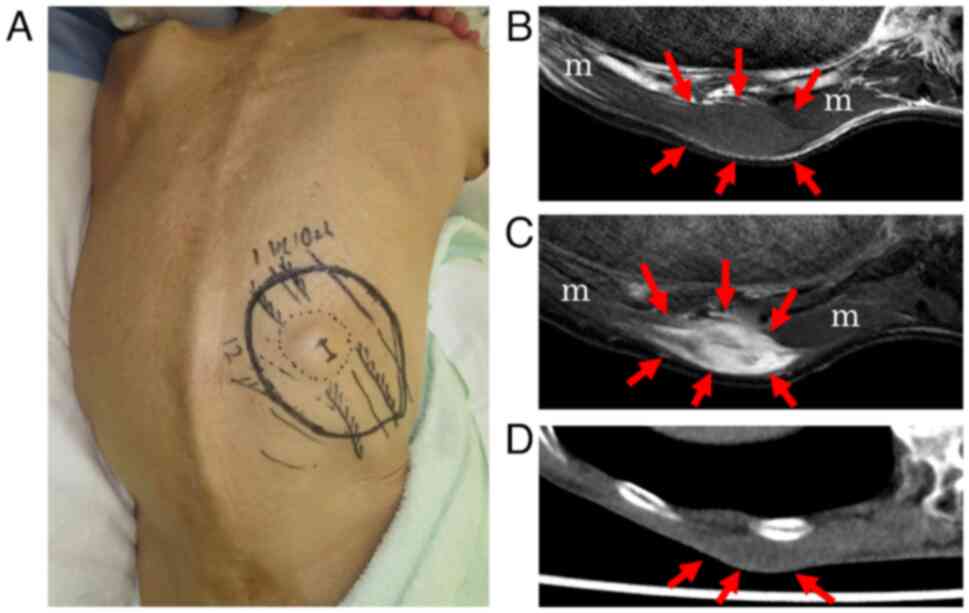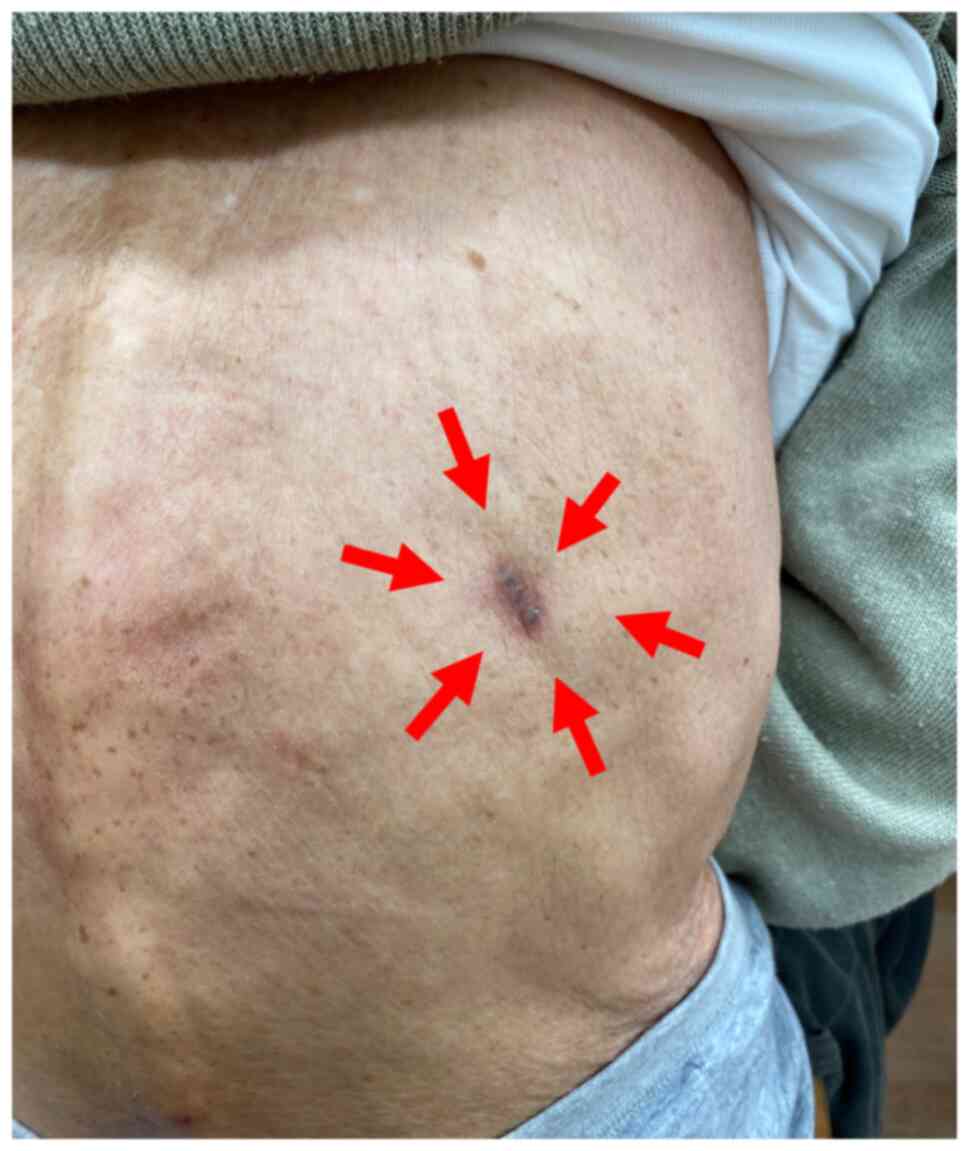Ischemic fasciitis in a mobile elderly patient: A case report
- Authors:
- Published online on: September 19, 2024 https://doi.org/10.3892/etm.2024.12724
- Article Number: 434
Abstract
Introduction
Ischemic fasciitis (IF) is a rare, benign fibroblastic/myofibroblastic proliferation that mimics a soft-tissue sarcoma both clinically and histologically. The majority of patients with IF are elderly and a number of them are debilitated or immobilized, bedridden or wheelchair-bound (1-3). Its favored locations are trunk regions over bony prominences, such as the shoulder, sacrum or greater trochanter (1-3). Most patients show a painless mass of short duration, usually <6 months (3). IF tend to be poorly circumscribed and multinodular, and typically involves subcutaneous tissue (3). Proliferating cells in IF may be cytologically atypical features with hyperchromatic swollen nuclei and prominent nucleoli (3). From the therapeutic point of view, an accurate diagnosis is needed because most IF cases are cured by conservative therapy alone (3). We encountered an elderly, mobile patient with IF that was clinically suspected of being an aggressive sarcoma. We herein describe the clinicopathological features of the present case to share our experience of such self-limiting, pseudosarcomatous lesions.
Case report
A 76-year-old man, in good health and self-supporting as regards activities of daily living (ADL), except for medication for hypertension, was admitted to the National Defense Medical College Hospital (Tokorozawa, Japan). His chief complaint was a slowly growing, painless soft-tissue mass that had been evident on his right back for two months. He was relatively thin, and the mass was located above a rib bone. This mass was chicken-egg-sized, elastic hard, and immobile without skin ulceration (Fig. 1A). An ultrasound examination showed a mass with an acoustic shadow and highly echogenic capsule. Magnetic resonance imaging (MRI) revealed a 33-mm subcutaneous mass focally involving the latissimus dorsi muscle. T1-weighted (T1W) images showed a signal that was slightly hyperintense versus skeletal muscle (Fig. 1B), while T2-weighted (T2W) and diffusion-weighted imaging (DWI) showed hyperintense signal mixed with heterogeneous low-intensity areas (Fig. 1C). Tail-like signs were observed from this tumor. X-ray computed tomography (CT) showed no bony involvement (Fig. 1D). These imaging features indicated a possible diagnosis of myxofibrosarcoma or other myxoid sarcoma. Extensive surgical resection was planned, and a preoperative incisional biopsy was performed. Based on the resulting pathological diagnosis, the scheduled surgery was canceled, and the patient was placed under conservative observation. This tumor gradually shrank in size, and had completely disappeared after ~5 months (Fig. 2). One year after the biopsy procedure, the patient is alive, and remains well with no recurrence.
Pathological findings
The biopsy specimens were composed of fragmented soft tissues, and showed spindle or stellate cells, sometimes with swollen round-to-oval nuclei, proliferating within the myxoid fibrous tissues (Fig. 3A). Fibrin-like material deposits were also present in the myxoid stroma (Fig. 3B). Cellularity was relatively low, but focal cellular areas composed of short spindle cells with hyperchromatic nuclei were found. Some proliferating cells had conspicuous nucleoli. No abnormal mitoses were observed. Granulation tissue-like neovascularization containing enlarged endothelial cells was focally recognized (Fig. 3C). Necrotizing vasculitis was not observed. Immunohistochemically, proliferating spindle/stellate cells were focally positive for CD68 (PGM1) (Fig. 3D) and negative for keratin (AE1/AE3), alpha-smooth muscle actin, S-100 protein, myogenin, desmin, and CD34. The Ki-67 index was ~25% in hot spots (Fig. 3E). These findings suggested a diagnosis of IF.
Discussion
IF was first described as ‘atypical decubital fibroplasia’ by Montgomery et al in 1992(1), and similar lesions were reported by Perosio et al as ‘ischemic fasciitis’ in 1993(2). IF is a pseudosarcomatous proliferative disease of reactive fibroblasts/myofibroblasts associated with repair or healing of tissues that are necrotic or destructed, possibly due to intermittent ischemia (1-3). IF commonly occurs at sites of chronic mechanical pressure and abrasion, such as bony prominences during prolonged bed rest, immobilized postures, and wheelchair or orthotic use, particularly in debilitated elderly patients (1-10). IF uncommonly arises in young or middle-aged patients, and in almost all such cases it is associated with physical pressure or trauma (1,2,4-8). In the present case, the patient was elderly, but mobile and independent in ADL with no traumatic or decubital episodes. Therefore, making a clinical diagnosis of IF was challenging. The back was also considered not to be a favored location for IF. Retrospectively considered, however, the patient was relatively thin, suggesting that ischemia could occur just above the rib bone.
IF is a benign disease that is expected to resolve spontaneously in some cases (11). However, as in our case, IF sometimes shows cellular atypia, a variable frequency of mitosis, or myxoid changes in the stroma, and may mimic sarcomatous lesions, such as myxofibrosarcoma, myxoid chondrosarcoma, undifferentiated pleomorphic sarcoma, and epithelioid sarcoma (1,2,4-6). In excisional specimens, ‘zonal features’, which consist of a central necrotic area and peripheral proliferation of fibroblasts/myofibroblasts with granulation-like reactive vascular hyperplasia and inflammatory cells, are useful for diagnosis as they are not seen in sarcomas (1-4,6,7,11-14). There is a high risk of misdiagnosis due to the likelihood of zonal features being unclear in the fine-needle aspiration specimens (6,15) and probably in other small specimens. In the present case, the biopsy specimens were small and fragmented, and zonal features were indistinct. However, the detailed histology revealed fibrinoid necrosis/fibrin-like deposits and myxofibrous stroma with focal neovascularization, findings that were suggestive of the central and peripheral parts of zonal features. In addition, degenerative and reactive changes are helpful for diagnosis, such as myxoid degeneration, fat necrosis, erythrocyte extravasation, and hemosiderin deposition (1,2,4).
An accurate diagnosis of IF is important to avoid unnecessary extensive surgery. In fact, in the present case, the tumor disappeared within several months after cancelation of the planned surgery. Even in piecemeal specimens where the zonal structure is unclear, in our experience the findings of a necrotic lesion with fibrous stroma and degenerative/reactive changes, such as myxoid changes, may provide us with clues to the correct diagnosis. A diagnosis of IF should be kept in mind and should be within lists employed for differential diagnosis when the patient is elderly, even if not bedridden or immobile.
In conclusion, the diagnosis of IF is challenging in patients with independent ADLs. The presence of fibrin-like deposits and myxofibrous stroma may be hallmarks for its correct diagnosis.
Acknowledgements
The authors thank Dr Robert Timms of English Language Editing in Biomedical Sciences (Birmingham, UK) for his skillful English-editing. The abstract was presented at the 111th Annual Meeting of the Japanese Society of Pathology Apr 14-16 2022 in Kobe, Japan and published as abstract no. P-176 in Proc Jpn Soc Pathol 111(1): 2022.
Funding
Funding: No funding was received.
Availability of data and materials
Data sharing is not applicable to this article as no datasets were generated or analyzed during the study.
Authors' contributions
AM and SM conceived and designed the study. AM and SM confirm the authenticity of all the raw data. AM, YS and SK provided examined materials. AM, YS, SO and SM performed the histopathological examination. SK and MS were involved in the patient's clinical management and analyzed patient data. AM, SO and YS collected appropriate references. AM wrote the paper. SM, SO and MS reviewed and edited the manuscript. All authors read and approved the final manuscript and agree to be accountable for all aspects of the research in ensuring that the accuracy of integrity of any part of the work are appropriately investigated and resolved.
Ethics approval and consent to participate
Ethical committee approval was provided from the Faculty of Medicine, National Defense Medical College board (approval no. 4480).
Patient consent for publication
Written consent for publication of the case report and any accompanying images, without any potentially identifying information, was provided by the patient.
Competing interests
The authors declare that they have no competing interests.
References
|
Montgomery EA, Meis JM, Mitchell M and Enzinger F: Atypical decubital fibroplasia. A distinctive fibroblastic pseudotumor occurring in debilitated patients. Am J Surg Pathol. 16:708–715. 1992.PubMed/NCBI | |
|
Perosio PM and Weiss SW: Ischemic fasciitis: A juxta-skeletal fibroblastic proliferation with a predilection for elderly patients. Mod Pathol. 6:69–72. 1993.PubMed/NCBI | |
|
Goldblum JR, Folpe AL and Weiss SW: Enzinger and Weiss's Soft tissue tumors. 7th edition. Elsevier Health Sciences, Philadelphia, PA, 2020. | |
|
Liegl B and Fletcher C: Ischemic fasciitis: Analysis of 44 cases indicating an inconsistent association with immobility or debilitation. Am J Surg Pathol. 32:1546–1552. 2008.PubMed/NCBI View Article : Google Scholar | |
|
Yamamoto M, Ishida T and Machinami R: Atypical decubital fibroplasia in a young patient with melorheostosis. Pathol Int. 48:160–163. 1998.PubMed/NCBI View Article : Google Scholar | |
|
Washing D and Zaher A: Pathologic quiz case: A 76-year-old debilitated woman with a right thigh mass. Ischemic fasciitis (atypical decubital fibroplasia). Arch Pathol Lab Med. 128:e139–e140. 2004.PubMed/NCBI View Article : Google Scholar | |
|
Sakamoto A, Arai R, Okamoto T, Yamada Y, Yamakado H and Matsuda S: Ischemic fasciitis of the left buttock in a 40-year-old woman with beta-propeller protein-associated neurodegeneration (BPAN). Am J Case Rep. 19:1249–1252. 2018.PubMed/NCBI View Article : Google Scholar | |
|
Baldassano MF, Rosenberg AE and Flotte TJ: Atypical decubital fibroplasia: A series of three cases. J Cutan Pathol. 25:149–152. 1998.PubMed/NCBI View Article : Google Scholar | |
|
Wader J, Gajbi N and Kumbhar S: Ischaemic fasciitis: A very rare entity with unusual presentation. J Clin Diagn Res. 7:2952–2953. 2013.PubMed/NCBI View Article : Google Scholar | |
|
Padmanaban D, Rangasami R, Chandrasekharan A and Swaminathan R: Decubital ischemic fasciitis presenting in an unusual location. Radiol Case Rep. 6(590)2015.PubMed/NCBI View Article : Google Scholar | |
|
Lehmer LM, Moore JB and Ragsdale BD: Ischemic fasciitis: enhanced diagnostic resolution through clinical, histopathologic and radiologic correlation in 17 cases. J Cutan Pathol. 43:740–748. 2016.PubMed/NCBI View Article : Google Scholar | |
|
Ulus OS, Karaarslan E, Saglican Y and Yakupoglu A: Case report: MRI of decubital ischemic fasciitis. Indian J Radiol Imaging. 21:111–112. 2011.PubMed/NCBI View Article : Google Scholar | |
|
Gavin M, Sharp L, Atkins R and Tarbox M: Ischemic fasciitis in a debilitated older man. Proc (Bayl Univ Med Cent). 32:429–430. 2019.PubMed/NCBI View Article : Google Scholar | |
|
Ilaslan H, Joyce M, Bauer T and Sundaram M: Decubital ischemic fasciitis: Clinical, pathologic, and MRI features of pseudosarcoma. AJR Am J Roentgenol. 187:1338–1341. 2006.PubMed/NCBI View Article : Google Scholar | |
|
Chatura KR, Katyal A and Hiremath SS: Fine-needle aspiration cytology in soft tissue tumors: How far did we go? J Adv Clin Res Insights. 2:107–111. 2015. |














